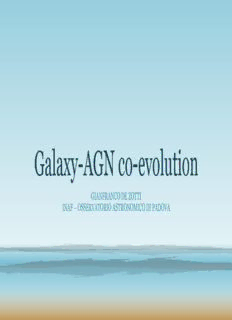
Galaxy-AGN co-evolution PDF
Preview Galaxy-AGN co-evolution
Galaxy-AGN co-evolution GIANFRANCO DE ZOTTI INAF – OSSERVATORIO ASTRONOMICO DI PADOVA Layout • Introduction to AGNs • AGN host galaxies • BH mass estimates • BH growth. The Sołtan argument • How can AGNs affect the host galaxy? • AGN impact on galaxy evolution. Feedback • Do stellar and BH masses really grow in parallel? • Conclusions The quasar discovery Maarten Schmidt (1963, Nature): 3C273 The stellar object is the nuclear region of a galaxy with a cosmological redshift of 0.158, corresponding to an apparent velocity of 47,400 km/s. The distance would be around 500 megaparsecs, and the diameter of the nuclear region would have to be less than 1 kiloparsec. This nuclear region would be about 100 times brighter than the luminous galaxies which have been identified with radio sources so far … 3C273 The luminosity of active nuclei is due to accretion onto black holes. Ya. B. Zeldovich (1963) • The total energy output from a quasar is at least the energy stored in its radio halo ( 1054 J=1061 erg); via E=mc2 this corresponds to 107 M . sun • Nuclear reactions have at best an efficiency of 0.7% (H burning). So the waste mass left behind in powering a quasar is > 109 M . sun • Rapid brighness variations show that a typical quasar is no bigger than a few light-hours. But the gravitational energy of 109 M compressed sun within this size is 1055 J, i.e. 10 times larger than the fusion energy. "Evidently, although our aim was to produce a model based on nuclear fuel, we have ended up with a model which has produced more than enough energy by gravitational contraction. The nuclear fuel has ended as an irrelevance." Donald Lynden-Bell (1969) The idea that active galactic nuclei (AGNs) are powered by accretion onto supermassive BHs was elaborated by several authors (Hoyle & Fowler 1963; Salpeter 1964; Zel’dovich 1964; Lynden-Bell 1969, 1978; Lynden-Bell & Rees 1971) and quickly gained acceptance. Although it was clear from the beginning that quasars are located in the nuclei of galaxies, their presence was considered for decades just as an incidental diversion, an ornament irrelevant for galaxy formation and evolution: • The physical scale of the AGNs is incomparably smaller than that of galaxies: typical radii of the stellar distribution of galaxies are of several kpcs, to be compared with the Schwarzschild radius r =2GM /c29.56x10-6 (M /108 M ) S BH BH sun pc; i.e. r 10-9 r . BH gal • The radius of the "sphere of influence" of the BH (the distance at which its potential signifcantly affects the motion of the stars or of the ISM) is also small: r =GM / 211 (M /108 M ) /( /200 km/s)2 pc. Hence even large BH have inf BH BH sun a negligible impact on the global stellar and ISM dynamics. Even in nearby galaxies the angular scale associated to r is small, 0.2 (M /108 M ) ( /200 inf BH sun km/s)-2 (D/10 Mpc)-1 arcsec. • Quasars are much rarer than galaxies at low redshifts, where galaxies were most extensively studied, and become much more numerous at z 2 (evolution much stronger than that of galaxies). BH demographyc studies • On the other hand, the BHs powering the quasars at high z do not disappear. After they stop accreting, they should live essentially forever as dark remnants. So dead quasar engines should hide in many nearby galaxies (Schmidt 1978). • However, the required BH masses are a tiny fraction of the stellar mass (let alone the total mass!) of galaxies (~0.1% M ) and their radius of influence is very small. Thus dynamical evidence for BHs is hard to find; the first stellar dynamical BH detections followed in the mid- to late-1980s, when CCDs became available on spectrographs and required the excellent seeing of observatories like Palomar and Mauna Kea (see Kormendy & Richstone 1995 for a review). • The Hubble Space Telescope (HST), by delivering five-times-better resolution than ground-based, optical spectroscopy, made it possible to find BHs in many more galaxies. • This led to the convincing conclusion that BHs are present in essentially every galaxy that has a bulge component. AGN host galaxies Optical R-band Hubble Space Telescope images of z ~0.1 Seyfert 1 galaxies and quasars. Some of these nearby AGNs have elliptical hosts, but most have hosts that are early-type spirals, which have a substantial bulge component. Layout • Aggiungere qui il primo punto elenco • Aggiungere qui il secondo punto elenco • Aggiungere qui il terzo punto elenco
Description: